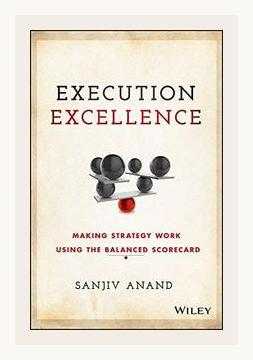Business StrategyStrategic Execution
Introduction
“Execution Excellence: Making Strategy Work Using the Balanced Scorecard” by Sanjiv Anand offers an in-depth exploration of how to translate strategic visions into operational reality using the Balanced Scorecard (BSC) framework. The author, leveraging his extensive consulting experience, demystifies strategic execution and provides actionable insights for ensuring strategies do not remain mere plans but become actual results. This summary condenses the key lessons and practical steps offered in the book, through structured points and real-world examples.
1. The Importance of Execution
Key Points
- Gap Between Strategy and Execution: Many organizations fail not because of flawed strategies but because of inadequate execution.
- Role of Balanced Scorecard: The BSC serves as a bridge between strategic planning and execution by translating abstract strategies into measurable activities and outcomes.
Actions
- Define Clear Objectives: Use the BSC to identify and clearly outline your strategic objectives.
- Align Activities: Ensure all activities across the organization are aligned with these objectives.
Example
Anand describes a manufacturing company struggling with operational inefficiencies. Implementing the BSC helped them pinpoint specific objectives, such as reducing production downtime, and align all team activities towards achieving these goals.
2. Four Perspectives of the Balanced Scorecard
Key Points
- Financial Perspective: Focuses on financial performance metrics.
- Customer Perspective: Centers on customer satisfaction and relationships.
- Internal Process Perspective: Highlights internal operational goals and efficiencies.
- Learning and Growth Perspective: Emphasizes employee training, culture, and innovation.
Actions
- Develop Metrics for Each Perspective: Clearly define and prioritize metrics in each BSC category for balanced organizational growth.
- Integrate Across Departments: Encourage departments to use these perspectives as guidelines for setting their own metrics.
Example
A telecommunications company used BSC to improve customer service. Concentrating on the Customer Perspective, they introduced metrics such as “average call resolution time” and “customer satisfaction score,” which led to significant improvements in service quality.
3. Strategy Mapping
Key Points
- Visual Representation: A strategy map visually connects strategic objectives across the four BSC perspectives.
- Cause-and-Effect Relationships: It highlights how short-term goals drive long-term objectives, fostering a clear understanding across the organization.
Actions
- Create a Strategy Map: Develop a visual map showing how various objectives interconnect and support one another.
- Communicate the Map: Share this map widely within the organization to ensure everyone understands the overarching strategy.
Example
Anand discusses a hospital that created a strategy map to better align their healthcare services with patient care goals. This visual tool helped clinicians and administrators alike to understand how financial discipline and operational efficiency contribute to superior patient outcomes.
4. Setting Targets and Initiatives
Key Points
- Specific, Measurable Targets: Organizations must establish clear, quantifiable targets for each strategic objective.
- Initiatives to Achieve Targets: Develop initiatives/actions that will drive performance to meet these targets.
Actions
- Set SMART Targets: Ensure that goals are Specific, Measurable, Achievable, Relevant, and Time-bound.
- Align Initiatives with Goals: Design initiatives directly linked to meeting these targets; assign ownership and deadlines.
Example
Anand illustrates with an example of a bank aiming to increase customer retention. They set a target to boost retention by 15% within a year. Relevant initiatives included enhancing the mobile banking experience and launching personalized marketing campaigns.
5. Performance Measurement and Feedback
Key Points
- Ongoing Measurement: Continuously monitor performance through the established metrics.
- Feedback Loops: Implement feedback mechanisms to adjust strategies and initiatives based on performance data.
Actions
- Regular Reporting: Institute regular performance reports to keep track of progress against targets.
- Adjust Based on Data: Be prepared to tweak strategies and initiatives as new data and feedback become available.
Example
A retail chain experienced challenges with inventory management. By monitoring inventory turnover rates through the BSC metrics and establishing feedback loops, they improved their stock management processes, resulting in better shelf availability and increased sales.
Conclusion
“Execution Excellence” by Sanjiv Anand is a hands-on guide for organizations grappling with the ‘execution gap.’ Through the Balanced Scorecard framework, Anand advises how to transform strategy into action, ensuring a comprehensive, balanced approach to organizational growth. The strategic insights, backed by real-world examples and actionable steps, offer a blueprint for achieving execution excellence across various industries.
By adopting and customizing these lessons within the specific context of their operations, leaders can drive their organizations towards achieving strategic goals effectively and sustainably.
